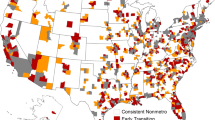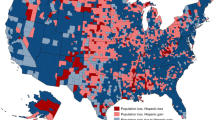Abstract
Can immigration save rural and small town America? Our goal is to highlight the new racial dynamics of population change in nonmetropolitan areas, where slowing population growth rates since 1990 eventuated in widespread depopulation during the post-2010 period. We use 3141 counties as the unit of analysis, tracking population change data over the 1990 to 2017 period. Our results, based on decennial census counts and population estimates from the U.S. Census Bureau, show that Hispanic population growth has been spatially ubiquitous, occurring in both declining and growing nonmetropolitan counties. Hispanic growth has slowed but not reversed chronic declines in rural population. Significantly, the growth of Latinos benefited a majority of historically depopulating or declining nonmetropolitan counties as well as nonmetropolitan counties that have continued to grow. Our analyses also reveal substantial heterogeneity in patterns of population change in nonmetropolitan America. Latino population growth often makes the difference between overall county population growth and decline. Nearly 200 nonmetropolitan counties grew during the 2010–2017 period, but only because Hispanic population increases offset non-Hispanic population declines. For these counties, which account for about 10 percent of all nonmetropolitan counties, Latinos clearly provided a demographic lifeline. Hispanics population gains were usually insufficient to reverse population declines in historically depopulating counties but nevertheless slowed the pace of decline. Hispanic growth was greatest in counties where the population was growing, resulting in a demographic multiplier effect.






Similar content being viewed by others
Notes
We recognize that all Hispanics or Latinos are not immigrants—the so-called first generation or foreign-born population. However, demographers often refer to the Hispanic immigrant stock, which is comprised of both first- and second-generation (i.e., U.S.-born of foreign-born parents). By this definition, 83 percent of all adult Hispanics are of immigrant stock (Pew Research Center 2004), the population group that dominates the new patterns of net migration and redistribution in rural America (Lichter and Johnson 2012). In 2014, immigrant stock accounted for roughly 2/3rds of the Latino population, including children (Waters and Pineau 2016).
In this paper, we use Hispanics and Latinos interchangeably, recognizing that Hispanics is a term typically used by the Census Bureau in demographic reports or by demographers, but also is sometimes found objectionable among racial and ethnic scholars who prefer Latino/a/x.
After every decennial census, the universe of metropolitan and nonmetropolitan counties is updated to reflect country population growth over the proceeding decade. Our analysis is based on the same universe of nonmetropolitan counties throughout the 1990–2017 study period.
Several hundred counties that would have been classified as nonmetropolitan under previous OMB definitions are included among metropolitan areas here. Reclassification has, over the course of several decades, removed many fast growing counties from the universe of nonmetropolitan counties and reclassified them as metropolitan. Our goal is to keep the focus squarely on today’s nonmetropolitan counties and the historically demographic processes that underlay recent trajectories of population growth and decline.
References
Broadway, M. (2007). Meatpacking and the transformation of rural communities: a comparison of Brooks, Alberta and Garden City, Kansas. Rural Sociology, 72(4), 560–582.
Carr, P. J., Lichter, D. T., & Kefalas, M. J. (2012). Can immigration save small-town America? Hispanic boomtowns and the uneasy path to renewal. The Annals of the American Academy of Political and Social Science, 641(1), 38–57.
Collantes, F., Pinilla, V., Sáez, L. A., & Silvestre, J. (2014). Reducing depopulation in rural Spain: the impact of immigration. Population, Space and Place, 20(7), 606–621.
Cromartie, J. (2017). Recent population change. Retrieved April 4, 2018 from https://www.ers.usda.gov/topics/rural-economy-population/population-migration/recent-population-change/.
Crowley, M., & Ebert, K. (2014). New rural immigrant destinations: research for the 2010s. In C. Bailey, L. Jensen, & E. Ransom (Eds.), Women, minorities, and employment discrimination (pp. 401–418). Rural America in a Globalizing World: Problems and Prospects for the 2010s. Morgantown: West Virginia University Press.
Crowley, M., & Lichter, D. T. (2009). Social disorganization in new Latino destinations? Rural Sociology, 74(4), 573–604.
Crowley, M., & Knepper, P. (2019). Strangers in their hometown: demographic change, revitalization and community engagement in new Latino destinations. Social Science Research, 79(1), 56–70.
Ely DM, & Hamilton BE. (2018). Trends in fertility and mother’s age at first birth among rural and metropolitan counties: United States, 2007–2017. NCHS Data Brief, no 323. Hyattsville, MD: National Center for Health Statistics. 2018.
Economic research service. (2019). Rural population and migration briefing room. Retrieved on November 30, 2019 from www.ers.usda.gov/briefing/population/
Economic research service. (2018). Rural America at a glance. 2018 Edition. Economic Information Bulletin 200. U.S. Department of Agriculture. Retrieved on November 30, 2019 from https://www.ers.usda.gov/webdocs/publications/90556/eib-200.pdf?v=5899.2
Fikri K., & Lettieri, J. (2019). ‘Our country is full’: Trump says migrants straining immigration system. Retrieved December 3, 2019 at https://www.pbs.org/newshour/politics/our-country-is-full-trump-says-migrants-straining-immigration-system.
Fuguitt, G. V., Heaton, T. B., & Lichter, D. T. (1988). Monitoring the metropolitanization process. Demography, 25(1), 115–128.
Hall, M., Tach, L., & Lee, B. A. (2016). Trajectories of ethnoracial diversity in American communities, 1980–2010. Population and Development Review, 42(2), 271.
Hedlund, M., Carson, D. A., Eimermann, M., & Lundmark, L. (2017). Repopulating and revitalising rural Sweden? Re-examining immigration as a solution to rural decline. The Geographical Journal, 183(4), 400–413.
Jensen, L., & Yang, T. C. (2016). Taken by surprise: new immigrants in the rural United States. In B. Jentsch & M. Simard (Eds.), International Migration and Rural Areas : Cross-National Comparative Perspectives (pp. 33–58). New York: Routledge.
Johnson, K. M. (2011). The continuing incidence of natural decrease in American counties. Rural Sociology, 76(1), 74–100.
Johnson, K. M. (2020). Subnational non-Hispanic white natural decrease in the United States. Population and Development Review, 46(1), 7–31.
Johnson, K. M., & Lichter, D. T. (2008). Natural increase: a new source of population growth in emerging Hispanic destinations in the United States. Population and Development Review, 34(2), 327–346.
Johnson, K. M., & Lichter, D. T. (2016). Diverging demography: Hispanic and non-Hispanic contributions to US population redistribution and diversity. Population Research and Policy Review, 35(5), 705–725.
Johnson, K. M., & Lichter, D. T. (2019). Rural depopulation: growth and decline processes over the past century. Rural Sociology, 84(1), 3–27.
Johnson, K.M., & Winkler, R.L. (2015). Migration signatures across the decades: Net migration by age in U.S. Counties, 1950-2010. Demographic Research, 22(38), 1065–1080.
Kandel, W., & Cromartie, J. (2004). New Patterns of Hispanic Settlement in Rural America. Rural Development and Research Report 99. Economic Research Service, US Department of Agriculture.
Kandel, W., & Parrado, E. A. (2005). Restructuring of the US meat processing industry and new Hispanic migrant destinations. Population and Development Review, 31(3), 447–471.
Krumel, T. P., Jr. (2017). Anti-immigration reform and reductions in welfare: evidence from the meatpacking industry. Choices, 32(1), 1–7.
Kritz, M. M., & Gurak, D. T. (2018). Spatial dispersion of US national origin groups: characteristics of dispersed immigrants and settlement places. Population, Space and Place, 24(8), e2154.
Lee, B. A., & Sharp, G. (2017). Ethnoracial diversity across the rural-urban continuum. The ANNALS of the American Academy of Political and Social Science, 672(1), 26–45.
Lichter, D. T. (2012). Immigration and the new racial diversity in rural America. Rural Sociology, 77(1), 3–35.
Lichter, D. T. (2013). Integration or fragmentation? Racial diversity and the American future. Demography, 50(2), 359–391.
Lichter, D. T., Johnson, K. M., Turner, R. N., & Churilla, A. (2012). Hispanic assimilation and fertility in new US destinations. International Migration Review, 46(4), 767–791.
Lichter, D. T., Parisi, D., & Taquino, M. C. (2016). Emerging patterns of Hispanic residential segregation: lessons from rural and small-town America. Rural Sociology, 81(4), 483–518.
Lichter, D. T., Parisi, D., & Taquino, M. C. (2018). White integration or segregation? The racial and ethnic transformation of rural and small town America. City & Community, 17(3), 702–719.
McAreavey, R. (2017). New immigration destinations: migrating to rural and peripheral areas. London: Routledge.
Mathema, S., Svajlenka, N. P., & Hermann, A. (2018). Revival and opportunity: immigrants in rural America. Washington DC: Center for American Progress.
Mayer, Adam, Malin, Stephanie A., & Olson-Hazboun, Shawn K. (2018). Unhollowing rural America? Rural human capital flight and the demographic consequences of the oil and gas boom. Population and Environment, 39(3), 219–238.
Marrow, H. B. (2009). New immigrant destinations and the American colour line. Ethnic and Racial Studies, 32(6), 1037–1057.
Marrow, H. B. (2020). Hope turned sour: second-generation incorporation and mobility in U.S. new immigrant destinations. Ethnic and Racial Studies, 43(3), 99–118.
Nevarez, L., & Simons, J. (2020). Small-city dualism in the metro hinterland: the racialized “Brooklynization” of New York's Hudson Valley. City & Community, 19(1), 16–43.
Ozimek, A., Fikri, K., & Lettieri, J. (2019). From managing decline to building the future: could a heartland visa help struggling regions?. Washington, DC: Economic Innovation Group.
Parrado, E. A. (2011). How high is Hispanic/Mexican fertility in the United States? Immigration and tempo considerations. Demography, 48(3), 1059–1080.
Peters, D. J. (2019). Community resiliency in declining small towns: impact of population loss on quality of life over 20 years. Rural Sociology, 84(4), 635–668.
Peters, D. J., Hamideh, S., Zarecor, K. E., & Ghandour, M. (2018). Using entrepreneurial social infrastructure to understand smart shrinkage in small towns. Journal of Rural Studies, 64, 39–49.
Pew Research Center. (2004). Generational differences: fact sheet. March 19, 2004. Washington, DC. Accessed on April 4, 2020 at https://www.pewresearch.org/hispanic/2004/03/19/generational-differences/#first-generation-vs-second-generation
Sharp, G., & Lee, B. A. (2017). New faces in rural places: patterns and sources of nonmetropolitan ethnoracial diversity since 1990. Rural Sociology, 82(3), 411–443.
Voss, P.R., McNiven, S., Hammer, R.B., Johnson, K.M., & Fuguitt, G.V. (2005). County-specific net migration by five-year age groups, Hispanic origin, race, and sex, 1990–2000: [United States] (ICPSR 4171). Available at https://www.icpsr.umich.edu/icpsrweb/ICPSR/studies/4171
Waters, M.C, & Pineau, M.G. (2016). The integration of immigrants into American society. National Academies of Sciences, Engineering, and Medicine, & Committee on Population. Washington DC: National Academies Press.
Winders, J. (2005). Changing politics of race and region: Latino migration to the US South. Progress in Human Geography, 29(6), 683–699.
Winkler, R., Johnson, K. M., Cheng, C., Beaudoin, J., Voss, P. R., & Curtis, K. O. (2013). Age-specific net migration estimates for U.S. counties, 1950-2010. Applied Population Laboratory, University of Wisconsin-Madison.
Winkler, R. L., & Johnson, K. M. (2016). Moving toward integration? Effects of migration on ethnoracial segregation across the rural-urban continuum. Demography, 53(4), 1027–1049.
Author information
Authors and Affiliations
Corresponding author
Additional information
Publisher's Note
Springer Nature remains neutral with regard to jurisdictional claims in published maps and institutional affiliations.
Earlier drafts of this paper were presented at the conference of the European Society for Rural Sociology, Trondheim, Norway, June 25-28, 2019, and at the annual meetings of the Rural Sociological Society, Richmond, VA, August 7-10, 2019. The authors acknowledge the helpful comments of the co-editors and the external reviewers.
Rights and permissions
About this article
Cite this article
Lichter, D.T., Johnson, K.M. A Demographic Lifeline? Immigration and Hispanic Population Growth in Rural America. Popul Res Policy Rev 39, 785–803 (2020). https://doi.org/10.1007/s11113-020-09605-8
Received:
Accepted:
Published:
Issue Date:
DOI: https://doi.org/10.1007/s11113-020-09605-8




